Home » Goddess Nike: Ancient Greek Deity of Success and Victory
Goddess Nike: Ancient Greek Deity of Success and Victory
Even in modern times, Goddess Nike is known for victory and success.
Often depicted as a majestic, winged figure, she encapsulates the very essence of triumph and accomplishment.
Her iconic wings represent the swiftness and agility needed to conquer challenges.
And her poised demeanor symbolizes the grace of winning.
She is also a figure of elegance and strength, often shown with a laurel wreath in hand, ready to crown the victors.
In this guide, we’ll dive into the intriguing tales of Nike Goddess of Victory, discovering her origins, her family, and the important role she played among the gods and heroes of Greek mythology.
You’ll also see all the symbols she’s associated with, what her personality was like, and the most interesting facts from her mythology.
So let’s spread our wings and soar into the mythic past to uncover the story of Goddess Nike, a symbol of triumph and inspiration throughout the ages.
Who is Goddess Nike?
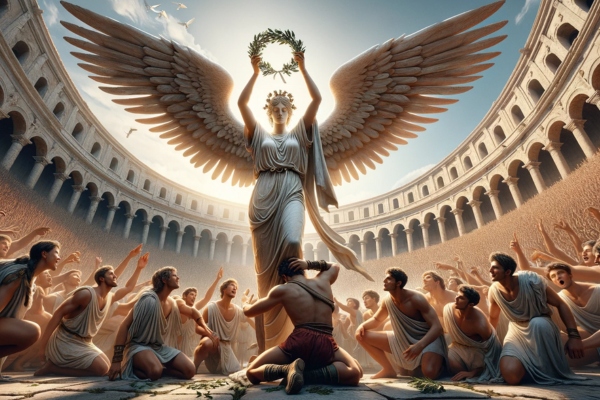
In the pantheon of Greek mythology, few deities capture the spirit of triumph and achievement as vividly as Goddess Nike.
That’s what made her so highly revered in ancient Greece and even today.
In his epic poems, “The Iliad” and “The Odyssey,” Homer often refers to her in the context of battle and victory.
She was often depicted with wings, symbolizing her swift nature and abilities.
This made her a popular figure in the athletic culture of Greece, where winning and excellence were highly prized.
She was frequently worshipped by warriors who would call upon her for assistance in achieving victory.
The belief was that invoking her would bring them good fortune on their quest for victory.
Her presence in myths often accompanied other major gods, like Zeus and Athena, highlighting her importance in the divine hierarchy.
Her Roman equivalent is Victoria, who shares many of the same attributes.
Think of Goddess Nike as the ultimate cheerleader for the ancient Greeks, always there to celebrate achievements and grant fame and glory to the victors.
Nike Goddess Facts
Here are some of the more interesting facts about Goddess Nike:
1. Trojan War: In the legendary Trojan War, she was closely associated with Athena, the goddess of wisdom and war strategy. She drove Athena’s chariot, signifying the combination of strategic wisdom and the pursuit of victory.
2. Her Depiction on Coins: In ancient Greece, she was frequently depicted on coins, symbolizing the wealth and prosperity that comes with victory. These coins were not only used as currency but also served as a form of propaganda, showcasing the influence and triumphs of the city-state that minted them.
3. Relationship with Zeus: In some myths, Nike was considered a close companion of Zeus, the king of the gods. She stood beside his throne and was believed to fly around battlefields rewarding the victors with glory and fame.
4. Celebrations and Worship: In ancient Greece, the goddess was celebrated in festivals and games, where her spirit of victory and competition was honored. Athletes would seek her blessings for success in their endeavors.
5. Symbolism in Politics and Warfare: Throughout history, she has been used as a symbol in political and military contexts, representing the pursuit and ultimate achievement of victory, whether it be in war, sports, or personal endeavors.
6. Role in the Gigantomachy: she is often depicted in the scenes of the Gigantomachy, the legendary battle between the gods and the giants. Her presence symbolizes the victory of the Olympian gods over the forces of chaos.
7. Relationship with the Nereids: In some artistic representations, Nike is shown in the company of the Nereids, sea nymphs. This association emphasizes her role as a messenger of victory, particularly in naval battles.
8. No Major Myths of Her Own: Unlike many other Greek gods and goddesses, she doesn’t have a distinct mythology or epic tales centered around her. Her presence is more symbolic, representing the concept of victory rather than being a central character in stories or myths.
9. Her Universal Appeal: The concept of victory transcends cultures and time periods, making her a universally appealing figure. Her representation in various forms of art across different cultures highlights her widespread influence.
10. Representation in Art: She is often depicted with wings, symbolizing her swift nature. In ancient art, she was shown crowning a victorious athlete or a god, signifying the awarding of glory and honor.
These facts about Nike, Goddess of Victory, showcase the many different areas of Greek mythology she had a lasting impact on.
She ruled in the realm of victory and success.
Nike’s Role in Greek Mythology
She might not be the lead character in every myth, but like a true unsung hero, she always plays a crucial role in the background.
In Greek mythology, Goddess Nike plays the role of rewarding victors in battles and competitions. She is often depicted as flying to the battlefield to crown the victor with laurel wreaths.
This act of recognition and reward was highly esteemed among ancient Greeks, signifying honor and glory for the triumphant warrior.
But her significance goes beyond physical battles; she also presides over intellectual or artistic contests.
For example, poets or playwrights who emerged victorious in competitions dedicated their success to her, seeking her favor for future endeavors.
Her association with glory, honor, and triumph is deeply rooted in Greek mythology.
Pindar, the Greek lyric poet, known for his odes to victorious Olympian athletes, frequently invoked Nike as a symbol of triumph in his works.
Her presence signifies not only the attainment of victory but also the celebration of excellence.
And the image of her holding a palm branch or wreath represents the enduring legacy of achievement.
Nike Goddess Symbols
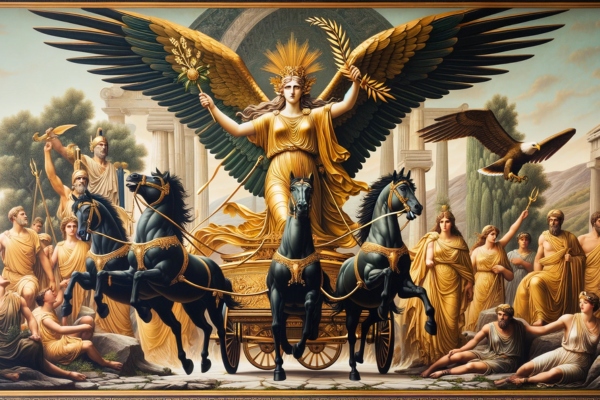
Now, let’s talk about one of the main things that makes her so iconic – Nike’s goddess symbols and how they’ve been represented through time.
• Her Wings: First up, let’s chat about those wings. In ancient Greek art, she was often depicted with wings. These wings represent speed and the ability to fly over the battlefield, crowning the victors with glory. It’s like she was the original superhero, swooping in to celebrate triumphs and achievements.
• Laurel Wreath: Then, there’s the laurel wreath. Ever wondered why athletes in the olden days were crowned with a bunch of leaves? Well, that’s thanks to Nike. The laurel wreath was a symbol of victory and honor, both in athletic competitions and in military conquests. It’s kind of like the ancient world’s version of a gold medal.
• Palm Branch: Her representation goes beyond just wings and wreaths, though. She was often shown holding a palm branch, another symbol of victory, or a sash to crown the victors. In some artworks, she’s even seen inscribing the names of winners on a shield. Talk about making your mark in history.
• Staff & Torch: In many representations throughout history, she is portrayed holding either a staff or torch, both Nike symbols representing authority and the impact associated with victorious endeavors. The staff represents leadership while the torch signifies enlightenment—both essential elements for achieving success in any endeavor.
• Victory Odes: In literature, especially in victory odes known as “epinikia” composed by poets like Pindar, she is symbolized as the ultimate end goal, embodying the glory of winning.
• Her Chariot: In some depictions, she is shown driving or accompanying a chariot, symbolizing her role in bringing victory in battle and her swift nature. In fact, sometimes she would accompany the mighty Zeus in her chariot.
• Eagle: The animal most commonly associated with Nike, the Greek goddess of victory, is the eagle. In ancient Greek art and mythology, the eagle is often depicted alongside her, symbolizing strength, speed, and the heights of achievement, qualities that align perfectly with the essence of victory that she represents.
• Gold Colors: The color most often associated with her is gold. Gold symbolizes triumph, success, and achievement, which aligns closely with her domain over victory. In ancient Greek art, she is frequently depicted with golden elements, be it in her attire or the laurel wreath she bestows upon victors.
But her influence isn’t just limited to ancient artifacts.
You’ll see her image in various forms even today, from statues in museums to modern logos.
These Nike Goddess symbols all contribute to her being known for success and achievement, inspiring people across generations.
Her Personality and Character Traits
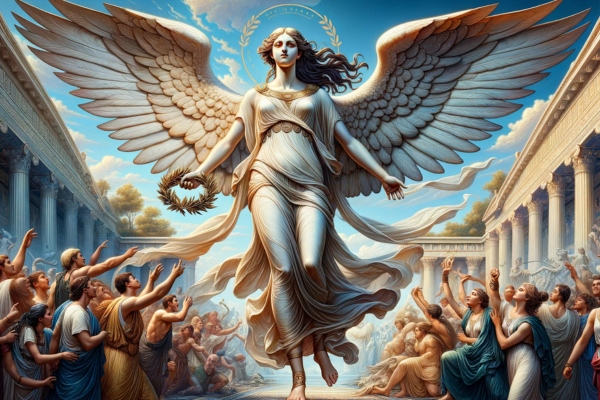
Based on her role as the goddess of victory and how she was depicted and revered in ancient Greek culture, we can infer several key traits and characteristics:
• Triumphant and Victorious: As the personification of victory, Goddess Nike’s personality embodies the spirit of triumph. She was celebrated for bringing success to all kinds of different competitive endeavors.
• Inspirational: She was seen as a source of inspiration and encouragement for those participating in competitions or warfare. Her presence was believed to uplift spirits and inspire determination and the pursuit of excellence.
• Symbolic and Emblematic: Nike’s character was more figurative than personal. She represented the ideal of victory and achievement, rather than having a distinct personality like other gods and goddesses.
• Swift and Agile: She was associated with swiftness and agility. This aspect of her character was essential in her role as a messenger who quickly spread news of victory.
• Neutral in Judgment: Unlike deities that were often depicted as taking sides, her role in bestowing victory was seen as more impartial. She represented the outcome of victory itself, rather than the moral or ethical standing of the victor.
• Supportive of the Worthy: There is an implication that she would support those who were most deserving of victory, be it in battle or in athletic competitions. This trait aligns her with the concept of rewarding hard work, skill, and merit.
Nike’s personality and character traits are more emblematic and representative of the concept of victory than they are indicative of individual characteristics or emotions.
She represents the glory of triumph and the aspiration for success in various activities.
Her Family Tree
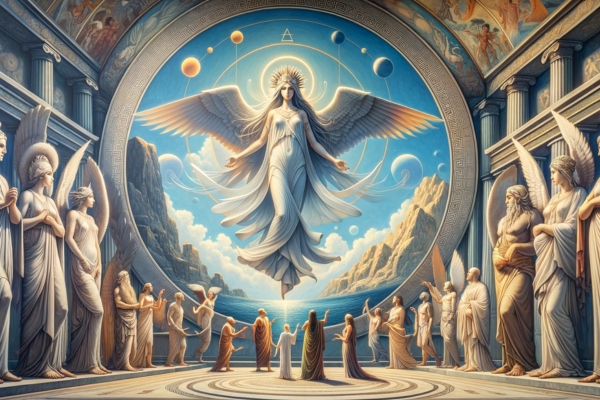
According to ancient poet Hesiod, Goddess Nike is the daughter of the Titan Pallas and the goddess Styx.
This makes her a second-generation deity with potent origins rooted in ancient Greek mythology.
Her parentage connects her to a line of formidable gods and goddesses that were revered by the ancient Greeks.
This lineage meant Nike’s goddess powers were formidable for a character who doesn’t have her own myth.
Siblings: Zelos, Kratos, and Bia
She has three siblings who embody different aspects of strength and might. Her brother Zelos represents rivalry, while Kratos embodies strength, and Bia symbolizes force.
Together, they create a formidable family unit that personifies various essential qualities revered in ancient Greece.
Connection to Other Gods and Goddesses
The family tree of Nike extends beyond her immediate relatives to connect with numerous other gods and goddesses in Greek mythology.
These connections illustrate how intertwined deities were within this rich tapestry of myths.
For example:
• Her mother Styx was associated with an important river in the underworld.
• Her aunt Themis was known as one of the Titans associated with divine law.
• She also had cousins such as Zeus, Poseidon, Hades, Hera, Demeter among others who played significant roles in Greek mythology.
How was Goddess Nike Worshipped?
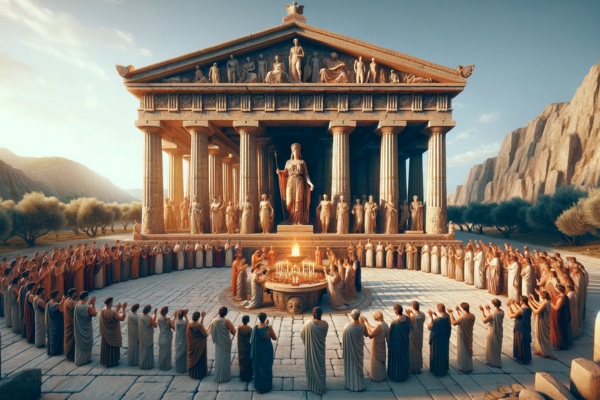
Goddess Nike was worshipped in ancient Greece by smaller but dedicated cults.
Her worship was not as extensive or elaborate as those of major Olympian deities like Zeus, Athena, or Aphrodite.
Here are some key aspects of her worship:
1. Temples and Altars: She had several temples and altars, often shared with other gods. The most famous was the Temple of Athena Nike on the Acropolis in Athens. This temple signified her worship as an aspect of Athena, the goddess of wisdom and war.
2. Sacrifices and Offerings: As with other Greek deities, worshippers of Nike likely made sacrifices and offerings at her temples. These could include animals, incense, or libations. Given her association with victory, offerings might also have included dedications from victorious athletes or soldiers, such as armor, weapons, or trophies.
3. Festivals and Games: She was closely associated with athletic and military success, so she was probably honored during various competitions and military victories. This could involve invoking her name during victory celebrations or dedicating sporting or battle successes to her.
4. Art and Symbolism: Her worship also occurred through artistic representations. She was frequently depicted in Greek art, notably in statues and on coins. These representations served not just as religious idols but also as symbols of the city-state’s power and success.
5. Integration with Other Deities: She was often worshipped in conjunction with other gods, especially Zeus and Athena, goddess of wisdom. She didn’t have a large independent following but was an integral part of the worship of these more dominant gods.
The worship of Nike was more about her symbolic value as a representation of victory and success, rather than a focus on her individual persona or mythology.
This worship was integrated into broader Greek religious practices and was particularly prominent in contexts related to competition and military success.
Her Temple and Cult Sites
The most famous temple dedicated to Nike is located on the Athenian Acropolis. This temple was a significant center for worshiping and honoring the goddess.
People from all over ancient Greece would travel to this temple to pay their respects and seek her blessings.
The architecture of the temple itself reflected her importance in Greek culture, with intricate designs and sculptures depicting her victories.
The temple on the Athenian Acropolis served as a place where people could come together to celebrate triumphs and offer gratitude for success.
It was not just a physical structure but also a symbol of hope, strength, and perseverance for the ancient Greeks.
Inside its walls, they found solace in knowing that victory was within reach with Nike’s divine favor.
Other Notable Cult Sites
Aside from the iconic temple on the Athenian Acropolis, there were other notable cult sites dedicated to her in ancient Greece. These included Olympia, Delphi, and Samothrace. Each of these sites held its own significance in honoring and venerating this exceptional goddess.
In Olympia, another prominent temple stood as an ode to the influence of Goddess Nike on athletic prowess and achievement.
As athletes competed in various games during festivals like the Olympic Games, they sought protection from this goddess, praying for victory before engaging in fierce competitions.
Delphi also boasted a sanctuary devoted to Nike where individuals came to express their gratitude after achieving personal or communal successes.
The presence of such sanctuaries highlighted how deeply integrated into daily life this goddess was — she represented not only military conquest but also triumphs in arts, sports, politics, and more.
Samothrace housed yet another revered site dedicated to her known as “the Sanctuary of the Great Gods.” Here too people gathered seeking blessings for successful endeavors or thanking her for past achievements.
These temples were crucial centers for worshiping Nike, providing communities with spaces where they could collectively honor her influence while seeking her divine assistance when facing challenges or pursuing victories.
Art and Sculptures of Goddess Nike
Many ancient statues and reliefs depict Goddess Nike crowning victorious athletes. In these artworks, she is often seen holding a wreath or palm branch, symbolizing victory.
The sculptures capture the essence of celebration and triumph as athletes are honored for their achievements.
The depiction of Nike in these sculptures serves as a strong symbol of success and glory. Artists skillfully crafted her image to embody the spirit of victory, inspiring awe and admiration among those who viewed these masterpieces.
These bronze statues and reliefs not only celebrated athletic prowess but also served as a reminder of divine favor.
They conveyed the belief that victory was not solely achieved through physical prowess but was also influenced by the goodwill of deities such as the winged goddess.
Graceful Motion
In many ancient works of art, the goddess is portrayed as a graceful figure in motion.
Her form exudes elegance, capturing the fluidity and grace associated with movement.
Whether depicted in flight or mid-stride, artists sought to convey an impression of effortless motion.
The portrayal of her graceful movements in ancient art reflects the reverence for athleticism and agility during that era.
Through these depictions, artists communicated an appreciation for physical prowess while elevating it to a divine level through their representation of her fluid motions.
Artists utilized various mediums such as marble, bronze, and stone to immortalize her elegant presence in their creations.
These materials allowed them to capture her dynamic form with remarkable precision while conveying a sense of timelessness through their craftsmanship.
Her Influence on Modern Culture
She was known as a influential figure who had a significant impact on modern culture, particularly through the iconic brand that bears her name.
The association with success and triumph is deeply embedded in the brand’s identity, making it a widely recognized symbol in various fields, especially sports.
The name “Nike” itself carries immense symbolism due to its origin from the goddess of victory.
Just like how the goddess brought victory to the Olympian gods during their battle against the Titans, the brand embodies this spirit of triumph and achievement.
For example, athletes often wear products bearing the famous swoosh logo to evoke feelings of confidence and success when competing or training.
The influence of this Greek Goddess extends far beyond just athletic wear; it has made a substantial impact on fashion trends as well.
From casual streetwear to high-end designer collections, clothing featuring the iconic swoosh emblem has become synonymous with style and urban culture.
Learning from Her Myth
The story of Goddess Nike teaches us about the importance of perseverance and determination.
In the story, she is depicted as a symbol of victory, representing the idea that success is achievable through unwavering determination.
This reminds us that in our own lives, when faced with challenges or setbacks, it’s essential to persist and remain determined.
For example, just like an athlete who continues to train hard despite facing obstacles, we too can overcome difficulties by staying committed to our goals.
Her portrayal as a figure embodying perseverance serves as an inspiration for individuals striving to achieve their dreams.
By internalizing this lesson from her myth, people can cultivate resilience and develop a strong sense of determination in pursuing their aspirations.
The story of Nike also encourages us to embrace challenges and strive for success. It emphasizes that triumph isn’t handed out easily; rather, it requires effort and dedication.
Just like athletes who face rigorous training regimens before achieving fame through their victories, individuals are reminded by her mythology that embracing challenges is an integral part of attaining success.
In addition to perseverance and determination, the myth also underscores the importance of strategic thinking in achieving victory.
While physical prowess certainly plays a role in athletic accomplishments, strategic planning and calculated moves are equally vital components for triumph.
Conclusion About Goddess Nike
And that’s a wrap on our exciting journey through the world of Nike Goddess of Victory.
From the heights of Mount Olympus to the fields of ancient Greece, she has been a symbol of triumph and success for centuries.
We’ve seen how her wings symbolize swiftness and how her laurel wreaths crown the victors, blending the realms of mythology and reality.
Whether driving Zeus’s chariot across the sky or crowning athletes in ancient games, Nike represents the best of victory – not just winning, but the spirit of excellence and achievement.
Her legacy continues in our modern world, reminding us that the pursuit of victory, in all its forms, is a timeless endeavor.
If you’re an athlete striving for gold, a student aiming for the top, or just someone chasing your dreams, her spirit is there to inspire and encourage you.
So, the next time you face a challenge, remember to spread your wings like Goddess Nike and aim for your very own success.
Table of Contents
2024 All rights reserved.
